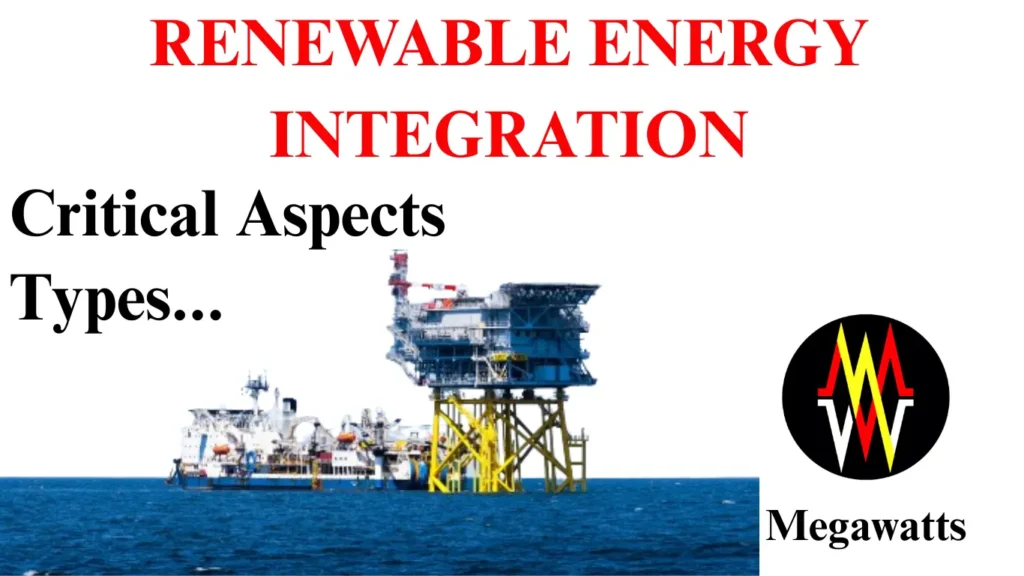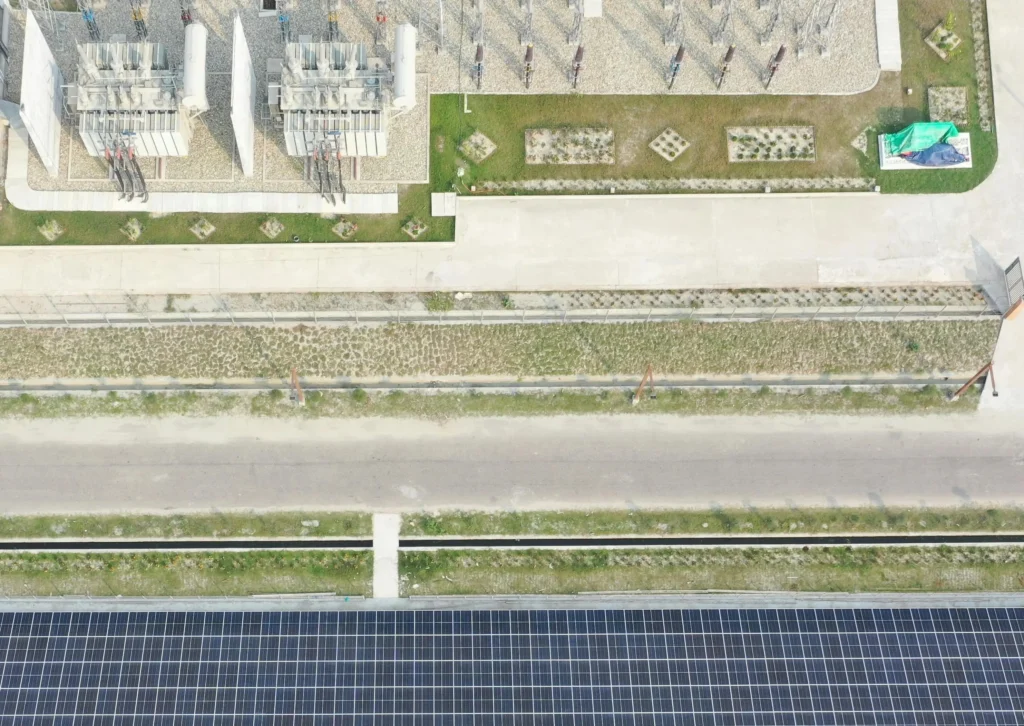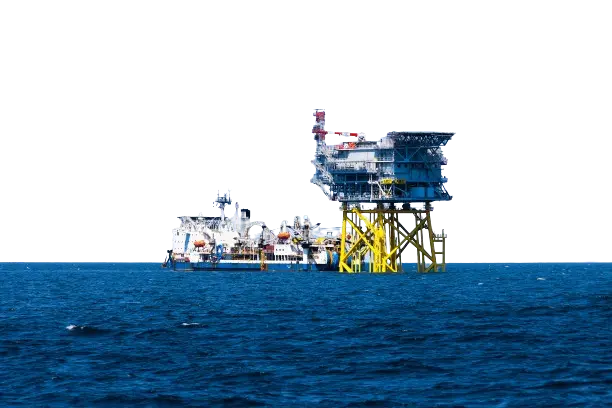
Renewable energy integration in a substation is the process of connecting the renewable energy-generating plants, like solar, wind, hydro, and biomass plants, to the electrical grid for the transformation and transmission of generated power.
Table of Contents
The renewable energy integration of the substation also refers to the substation being the sole interface that collects the power, converts it from DC to AC via inverters, the voltage is then stepped up via a step-up transformer, the power is stabilized so that power quality is maintained, and then is fed to the transmission circuit for transmission and distribution.
Critical aspect of renewable energy integration in the substation
Power collection: In a solar project, each panel generates DC power, and the power is collected via string combiners. In wind / hyrdo / biomass, the power is collected from the coupled generator, which is often AC, and the power electronic converters are used for voltage and frequency stabilization.
Power conversion: In solar projects, inverters are used to convert DC to AC power. This conversion happens inside the solar farm; however, for big solar projects, DC power is converted to AC in the substation by using a thyristor or Insulated Gate Bipolar Transistor (IGBT) based converters. At the plant level, the inverter used may be a String type, where every string of solar panels has its own inverter, or a central inverter, where multiple strings feed to a large inverter.
Power Transformation: The AC power is transformed to higher voltages for transmission to long-distance load centers. Most solar projects generate in the range of 400-700 V, wind projects in the range of 700-1 KV, while hydro and biomass generate at the synchronous voltage of 11 KV. This low voltage has to be transformed into high voltage for transmission, and it is achieved through step-up transformers.
Power quality management: The quality of power generated is managed and controlled at the substation. For the voltage synchronisation, the Transformer OLTC is used, which provides a steady output voltage despite fluctuation. Renewable energy integration causes frequency variation because the generation is not always at a stable rate. This is countered at the substation level by the synchronization relay and grid tie-inverter.
The power factor correction is achieved by adding STATCOM, SVCs, a Reactor, or capacitor banks. These absorb or inject the reactive power for maintaining a healthy power factor. Solar and wind projects are prone to producing distortion in the waveform, thus introducing harmonics. Passive and active harmonic filters are used to clean it.
Battery Energy Storage System (BESS) or flywheels are used to counter the sudden dips and spikes in the generation.
Protection coordination: The protection coordination is a bit different in the case of renewable energy integration than the conventional substation settings. This is mainly because of low fault current contribution from the inverter-based system, unlike the synchronous generators in conventional power generation. The condition of wind gusts and the solar array is not always the same, as it varies. This variation causes intermittency and affects the protection settings.
Because the generation is intermittent, at night, there is no power output from solar plants; the renewable sites need a supply to maintain critical processes, hence the power flow is bidirectional. This is also a key aspect of distributed generation, like wind and solar. Essential protection used in the DC side of the system is fuses and breakers, while under- and over-frequency relays are used to disconnect the plant from the grid in case of high variation in frequency. The rate of change of frequency (ROCOF) relay is used as an anti-islanding relay, which ensures that the plant is disconnected if the grid is out for the protection of personnel and equipment.
New Tech for Renewable Energy Integration
Digital Substation: Digital substation for renewable energy integration replaces the hard-wired copper wiring with faster optical fiber technology, which aids in increasing the speed of communication multiple-fold. It is based on the IEC 61850 standard. With the use of digital substation in renewable energy integration, the operation becomes smooth and safer as the fault detection and circuit isolation is achieved in milliseconds, improving protection selectivity.
FACTS: These are the devices of power electronics, which are used for increasing the control of AC transmission. Devices like STATCOM SVCs can aid in controlling voltage fluctuation caused due to renewable energy integration. These devices can improve the fault ride-through (FRT) capability of renewable plants, which essentially means that the plant will remain connected to the grid for short-duration faults like voltage disturbances and will not get isolated, which otherwise causes isolation and instability in the grid.
Forecasting and smart control: With the help of AI and IoT-based applications, the output forecast for renewable generation can be done with precision. This allows the SCADA system to manage the grid operation dynamically. Relay settings can be changed if the output is known based on the forecast. This also improves the grid operation as the operator conceives the data beforehand. The reliability of the system increases when the stress points are known.
Types of substation with renewable energy integration
Solar PV substation: These substation are used as an interface connecting a large solar power plant to the electrical grid. The conversion of bulk DC power is done via a large inverter and then is stepped up through a transformer for further transmission. STATCOMs are used for countering voltage fluctuation and managing reactive power.

Wind farm substation: The wind turbine generates variable AC power, which is essentially collected, transformed, and transmitted by the wind farm substation. The wind farm substations are of two types: one is an onshore wind farm substation, the other is an offshore substation, which is basically on water bodies.

Hybrid renewable substation: These substations are designed for multiple renewable energy integration, such as solar, wind, hydro, with or without storage capabilities within the substation. The hybrid design shares infrastructures and hence reduces the cost. Since multiple renewable energy sources are connected in it, the balancing between various intermittent sources is better in the case of hybrid substations. Integration with a battery energy storage system or pumped hydro improves the grid stability during output variations. The hybrid renewable substation also increases the efficiency of the transmission corridor.
This article is a part of the page Substation Guide.
